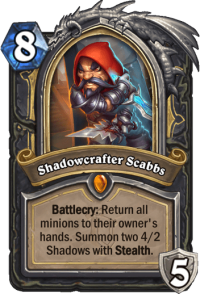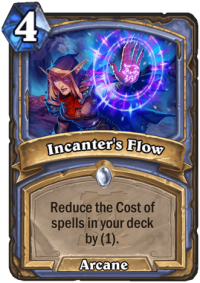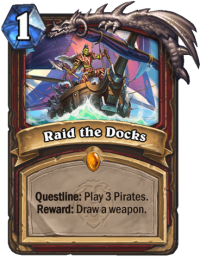On Tuesday 25 January, the big Hearthstone patch will finally arrive! There is a lot of stuff in this one, including Battlegrounds changes that will almost reinvent the whole game mode.
In this article, I want to dig deeper into what the patch means for Constructed. Standard is the more popular constructed game mode and the main target of the balance changes, but this time there are also changes directed at Wild. Why are these changes being made? What decks are they targeting? And finally, what can we expect the post-patch meta to look like?
Poison Rogue and Thief Rogue

The main target of the nerfs is Rogue. Three Rogue cards are being nerfed: all of them are used in Poison Rogue and two of them are used in Thief Rogue.
- Shadowcrafter Scabbs cost is increased from 7 mana to 8 mana.
- Wildpaw Gnoll cost is increased from 5 mana to 6 mana and Attack is reduced from 4 to 3.
- Cloak of Shadows cost is increased from 3 mana to 4 mana.
Poison Rogue’s ability to link back-to-back stealth turns and a Vanish turn with Shadowcrafter Scabbs is severely weakened. Turn 5 Cloak into turn 6 Cloak and turn 7 Scabbs has been back-breaking in pre-patch games. Now, Shadowcrafter Scabbs comes into play one turn later and it is more difficult to use poisons together with Cloak of Shadows to get the necessary damage in before Rogue runs out of Stealth cards.
Wildpaw Gnoll recently found its way into Poison Rogue, but as the deck uses no other enablers for Gnolls than Maestra of the Masquerade, making cheap Gnolls is much more difficult for the deck. The nerf will make Poison Rogue lose its way to contest early boards.
Poison Rogue was already vulnerable to the fastest aggro decks like Face Hunter, and now its vulnerability window is extended further. This gives decks like Beast Druid, Libram Paladin, and Aggro Elemental Shaman enough time to beat down Rogue on a consistent basis. This will effectively end Poison Rogue’s reign of terror.
Thief Rogue is hit less than Poison Rogue. The deck does not use Cloak of Shadows, and while Wildpaw Gnoll and Shadowcrafter Scabbs are its two best cards, they still remain usable in the archetype.

Wildpaw Gnoll played on turn two almost instantly wins the game and this has happened more than 12% of the time for Thief Rogue. Gnolls are most often played on turn three, and a 4/5 Rush minion that early is still extremely powerful. Turn four Gnolls are starting to be more manageable.
Starting out in Maestra of the Masquerade disguise, Rogue discounts the Gnoll by one with their natural draw each turn. Additional discounts are available from trading without breaking the disguise. Various card generation tools break the disguise. However, Secret Passage discounts the Gnoll by four before breaking the disguise.
With the more expensive Gnoll, a turn one Secret Passage can no longer draw 0-cost Gnolls. However, this was not a correct play mathematically anyway as the probability to draw a Gnoll from Secret Passage is not high enough. A turn two Secret Passage still makes Wildpaw Gnoll free. A turn one trade followed by Swashburglar and Wand Thief on turn two will now reduce the Gnoll to one mana.
Overall, turn two Gnoll should become almost non-existent now, but we can still expect to see them on turn three on a semi-regular basis. With one less attack, at least.
Generally, there has not been a huge difference between turn seven Shadowcrafter Scabbs and turn eight Shadowcrafter Scabbs. The matchups where it has made the largest difference are Warrior and Warlock. Warrior is getting nerfed and slowed down, so turn seven Scabbs is no longer important against them. Warlock, on the other hand, will enjoy an even more dominant matchup against Thief Rogue.
Decks like Beast Druid and Libram Paladin will greatly enjoy playing against a slower Thief Rogue, and previously good matchups like Face Hunter and Ramp Druid are at risk of becoming weaker.
Mozaki Mage

The cost of Incanter's Flow is increased to 4 mana. This will clearly affect Mozaki Mage’s power level. The deck’s win rate drops with each turn Flow is delayed, and I expect this nerf to be enough to make Mozaki Mage a non-issue in the upcoming meta.
If Poison Rogue had been nerfed without touching Mozaki Mage at the same time, there was a risk of Mage becoming too powerful. That risk has now been averted. Mozaki Mage was the only fast OTK deck left: the remaining OTK decks need to think about their survivability strategy a lot more as they cannot simply speed through their deck to victory.
Quest Warrior (Standard)

I did not expect to see Quest Warrior nerfed because of Standard, but that is what the developer comments say: the deck was nerfed to promote deck diversity in Bronze through Diamond.
Raid the Docks will require three Pirates for its second stage, so the overall number of Pirates needed to complete the Questline goes from seven to eight. In Standard, the Questline was often completed – and the Juggernaut summoned – on turn seven, sometimes on turn eight. This change will push it back by a turn as there is no mana (and often no card draw) available to do anything faster.
Quest Warrior has been almost completely eliminated from Legend play by Rogues, and this effect was already pushing it out from lower ranks as well. Right now, Quest Warrior peaks in Silver and starts to slowly deteriorate from there. There was a chance for Quest Warrior to make a comeback to higher ranks thanks to the Rogue nerfs. With this nerf, Quest Warrior should be almost completely erased from the ladder.
Rokara the Valorous buff
There is also one buff in the balance patch: Rokara, the Valorous will give you 10 Armor instead of 5 Armor. It is unlikely that this will make any new Warrior archetypes playable. It lets you play Rokara and Shield Shatter on the same turn, even from 0 Armor, but given how weak Control Warrior is, it’s not going to matter.
Standard Meta After the Balance Patch
With Poison Rogue, Mozaki Mage, and Quest Warrior effectively gone and Thief Rogue weakened, who will benefit?
The biggest beneficiaries are the decks that were the most oppressed by Poison Rogue and Mozaki Mage: Fel Demon Hunter, several varieties of Shaman (Quest, Bolner OTK, Elemental, Burn, Evolve), and Quest Rogue are some of the decks with the most to gain.
Libram Paladin may end up being challenged by the new meta if Quest Rogue manages to come back and Quest Shaman becomes one of the new top-tier decks. Libram Paladin should be strong enough to survive any meta, but being the best deck is more difficult.
Of the current top competitors, Beast Druid is in a good position. Beast Druid and Quest Shaman share a weakness against Quest Hand Warlock, which is also carefully watching the top spot on the ladder. Quest Hand Warlock can be kept at bay with Face Hunter and Fel Demon Hunter.
These are the top names I expect to see around in the post-patch meta. Quest Shamans, Beast Druids, and Quest Rogues beat Paladins and other slow decks. Quest Hand Warlock beats those three. Aggro beats Warlock. Paladins beat aggro.
It will take several rounds of responding to whoever comes out on top until we find a stable meta again. And no, I don’t expect Control Warrior to be part of it this time either. Control Warrior is well on its way to the land of myth alongside Control Hunter.
Wild Balance Changes!
While Raid the Docks was treated in patch notes as a Standard balance change, it will also affect Wild. Pirate Warrior is one of the best decks in the game, and slowing it down will have some effect in Wild too. However, Wild Pirate Warrior has access to tons of cheap Pirates and the phenomenal Ancharrr, which will still be drawn after the first three Pirates have been played. The deck is less vulnerable to being slowed down by the Questline nerf than its Standard counterpart.
There are also two Wild-only balance changes in the patch:
- Sorcerer's Apprentice cost is increased from 2 mana to 4 mana.
- Rapid Fire cost is increased from 1 mana to 2 mana.
The nerf to Sorcerer's Apprentice is huge. The current Ignite Mage decks cannot discount it and they also cannot tutor it with Witchwood Piper anymore. The Flamewaker list cannot pull Sorcerer's Apprentice with Drek'Thar, or even have the two cards in the same deck anymore. Wild Mage just went back to the drawing board.
Rapid Fire nerf is a big deal as well. Odd Questline Hunter just lost its best card: even-cost Rapid Fire no longer works with Baku the Mooneater.
Mecha’thun Warlock and Shudderwock Shaman are the most likely immediate winners of this patch in Wild, but we’ll see whether there will now be room for other meta developments in the evergreen format too.

I’ve got a Wild Thousand Truths Priest list that can reliably get the Sword by turn 7, and even as early as turn 5. In pre-Stormwind Wild, the venerable home of Razakus and Renolock, it would be considered toxic.
Which, in post-Stormwind Wild, is usually a turn too late, with the Seedlocks of yesteryear as well as Pirate Warriors, Odd Raza Hunters and Ignite Mages all having a pretty reliable turn 6 lethal, making my Truther Priest a fun tier 3 deck.
But now… who knows…
The new meta will be full of Druids!
I truly have no idea what’s gonna happen to Poison Rogue, but I will say that the deck deserved the nerfs, solely because decks without board interaction is totally awful.
You just draw, and draw, and hit face, and play garrote with spell damage. No fun at all.
On the other hand, freeze shaman have a chance if more board control deck resurface. and deathrattle & Big Demon DH still an option. Probably even seeing Ramp Druid even more.